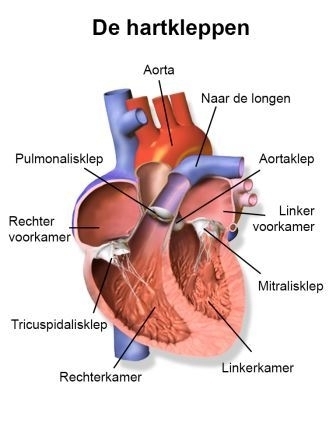Valve problems
Symptoms and causes
Symptoms and causesWhat is it?
The heart has four heart valves: the aortic, mitral, pulmonary and tricuspid valves.

Left side:
- The mitral valve is between the left ventricle and the atrium. They facilitate blood flow from the anterior chamber to the chamber.
- The aortic valve carries the blood from the left ventricle to the aorta. The oxygen-rich blood is brought from the aorta to the entire body.
Right side:
- The tricuspid valve is between the right ventricle and the atrium. It directs the blood from the right anterior chamber to the right chamber.
- The pulmonary valve is between the right atrium and the pulmonary artery. It directs the blood flow of oxygen-depleted blood from the right chamber to the lungs.
By opening and closing on time, the heart valves ensure that the blood flows at just the right moment. If one or more of the cardiac valves fail, the blood cannot be circulated properly. This is referred to as valve disease.
The failing valve can be constricted (allowing less blood through) or leaking (blood flows back).
Symptoms
With valve disease, symptoms only tend to arise once they are at an advanced stage. Many people have no or few symptoms initially.
Possible symptoms include:
- shortness of breath
- pain or tight feeling in your chest
- dizziness (sometimes fainting) with exertion
- fluid accumulation in the legs
- heart palpitations
- fatigue
Causes
Valve problems have various causes: The most common are:
- age-related calcification or degeneration
- congenital defects (e.g. bicuspid aortic valve)
- connective tissue disease (e.g. Marfan's Syndrome)
- heart attack
- infection
- trauma
- medication/drugs
- other
Diagnosis and treatment
Diagnosis and treatmentHow is the diagnosis made?
Cardiac valve function is analysed in various ways:
- Ausculation with a stethoscope
- Electrocardiogram
- Ultrasound via the chest (transthoracic ultrasound)
- Ultrasound through the oesophagus (transoesophageal ultrasound)
- Diagnostic cardiac catheterisation
Treatment
Treatment depends on multiple factors, particularly on the type of valve function and the nature of the abnormality.
Medication
Cardiac valves cannot be repaired with medication. The symptoms, such as shortness of breath and/or palpitations, can often be controlled or suppressed (temporarily). Medication makes it so that your heart has to work less hard.
Unblocking or widening the cardiac valve
During a cardiac catheterisation, a narrowed (calcified) valve can be stretched open with a balloon. This treatment is temporary, however, and the disease will return if no definitive treatment follows.
Balloon dilation is the least invasive technique for treating a narrowed (usually calcified) cardiac valve, but is definitely not always the first treatment option, precisely for that reason. Your cardiologist can determine if this is the appropriate treatment for you.
Repair or replacement of the cardiac valve
- Surgical procedure
The heart surgeon can repair or replace the failing valve. A valve can be replaced with a biological or mechanical artificial valve. The choice depends mostly on the patient's age.
- Non-surgical aortic valve implantation or transcatheter aortic valve implantation (TAVI)
Approximately 15-20% of the patients with aortic valve stenosis are not candidates for a surgical procedure because they are too old, have a serious secondary disease or have already had a prior treatment. As of the past few years, an aortic valve operation via the groin can be performed for these patients.
Treatment centres and specialisations
Treatment centres and specialisations
Latest publication date: 15/05/2024
Supervising author: Dr Provenier Frank





